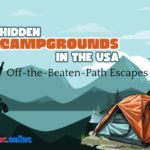Camping in national parks across the USA is an experience that combines the beauty of nature with the thrill of adventure. Whether you’re a seasoned camper or a first-timer, the United States offers a vast array of national parks, each with unique landscapes, wildlife, and camping opportunities. This guide will walk you through everything you need to know to plan the perfect camping trip, from selecting the ideal park to packing the essentials and understanding the regulations.
Why Choose National Parks for Camping?
National parks are the crown jewels of America’s natural heritage. They preserve the most stunning landscapes, diverse ecosystems, and historical sites, offering campers a chance to immerse themselves in unspoiled wilderness. From the towering peaks of the Rockies to the dense forests of the Appalachians, national parks provide a refuge from the hustle and bustle of modern life, allowing you to reconnect with nature.
Choosing the Right National Park
The USA is home to over 60 national parks, each offering a unique camping experience. Here are some factors to consider when choosing your destination:
- Location and Accessibility:
- Proximity to home or major cities.
- Accessibility via road or public transport.
- Nearby attractions or other parks.
- Landscape and Climate:
- Mountains, deserts, forests, or coastal areas.
- Seasonal weather conditions and best times to visit.
- Activities and Interests:
- Hiking, fishing, wildlife viewing, or stargazing.
- Historical or cultural significance.
- Campsite Availability:
- Popular parks like Yellowstone or Yosemite may require early reservations.
- Availability of backcountry sites for a more secluded experience.
Top National Parks for Camping
- Yellowstone National Park (Wyoming, Montana, Idaho)
- Best For: Geysers, wildlife, and hot springs.
- Must-See: Old Faithful, Grand Prismatic Spring, Yellowstone Lake.
- Yosemite National Park (California)
- Best For: Granite cliffs, waterfalls, and giant sequoias.
- Must-See: Half Dome, Yosemite Falls, Mariposa Grove.
- Great Smoky Mountains National Park (Tennessee, North Carolina)
- Best For: Lush forests, diverse wildlife, and historic sites.
- Must-See: Clingmans Dome, Cades Cove, Roaring Fork.
- Grand Canyon National Park (Arizona)
- Best For: Stunning vistas, hiking, and river rafting.
- Must-See: South Rim, North Rim, Bright Angel Trail.
- Zion National Park (Utah)
- Best For: Red rock formations, canyons, and adventure hiking.
- Must-See: Angels Landing, The Narrows, Emerald Pools.
Camping Regulations and Permits
Before heading out, familiarize yourself with the specific regulations of the park you plan to visit:
- Permits and Reservations:
- Many parks require camping permits, especially for backcountry sites.
- Popular parks often require advance reservations.
- Leave No Trace Principles:
- Always follow the Leave No Trace principles to protect the environment.
- Pack out all trash, minimize campfire impact, and respect wildlife.
- Campfire Rules:
- Check for fire restrictions, especially in dry areas.
- Use designated fire rings and never leave a fire unattended.
- Wildlife Safety:
- Store food in bear-proof containers where required.
- Keep a safe distance from all wildlife.
Packing Essentials for National Park Camping
Packing the right gear can make or break your camping experience. Here’s a list of essentials:
- Shelter:
- Tent with a rainfly and footprint.
- Sleeping bag appropriate for the season.
- Sleeping pad for comfort and insulation.
- Clothing:
- Layered clothing for changing weather conditions.
- Waterproof jacket and sturdy hiking boots.
- Hat, gloves, and thermal wear for cooler climates.
- Cooking Supplies:
- Portable stove or grill, fuel, and fire-starting tools.
- Cookware, utensils, and biodegradable soap.
- Cooler with ice packs and food storage containers.
- Navigation and Safety:
- Map, compass, or GPS device.
- First-aid kit and multi-tool.
- Headlamp or flashlight with extra batteries.
- Water and Food:
- Plenty of water and a filtration system for backcountry camping.
- Non-perishable food that’s easy to prepare.
- Miscellaneous:
- Insect repellent, sunscreen, and toiletries.
- Camping chairs, table, and tarp.
- Camera or binoculars for wildlife viewing.
Best Times to Camp in National Parks
The best time to camp varies depending on the park’s location and climate:
- Spring:
- Ideal for deserts and lower elevation parks.
- Wildflower blooms and milder temperatures.
- Summer:
- Popular season for most parks, but expect crowds.
- High elevation parks like Rocky Mountain are best visited in summer.
- Fall:
- Best for avoiding crowds and enjoying cooler temperatures.
- Fall foliage in parks like Acadia or Shenandoah is breathtaking.
- Winter:
- Great for desert parks or warmer climates.
- Snow camping in places like Yosemite can be a unique experience.
Top Tips for a Successful Camping Trip
- Plan Ahead:
- Research your chosen park’s website for the latest information.
- Book campsites or permits as early as possible.
- Stay Flexible:
- Weather can be unpredictable, so have a backup plan.
- Be prepared for changes in your itinerary.
- Respect Nature:
- Follow all park rules and regulations.
- Leave the area as you found it, or better.
- Engage in Park Activities:
- Join ranger-led programs for educational experiences.
- Explore lesser-known trails or viewpoints for solitude.
- Capture the Moments:
- Bring a camera to document your adventures.
- Consider journaling your experiences for lasting memories.
Conclusion
Camping in national parks across the USA offers an unparalleled opportunity to experience the country’s natural beauty. By choosing the right park, preparing adequately, and respecting the environment, you can create memories that will last a lifetime. Whether you’re watching the sunrise over the Grand Canyon, hiking through the towering redwoods of Yosemite, or simply relaxing by a campfire under the stars, America’s national parks are waiting to be explored.
Happy camping!



